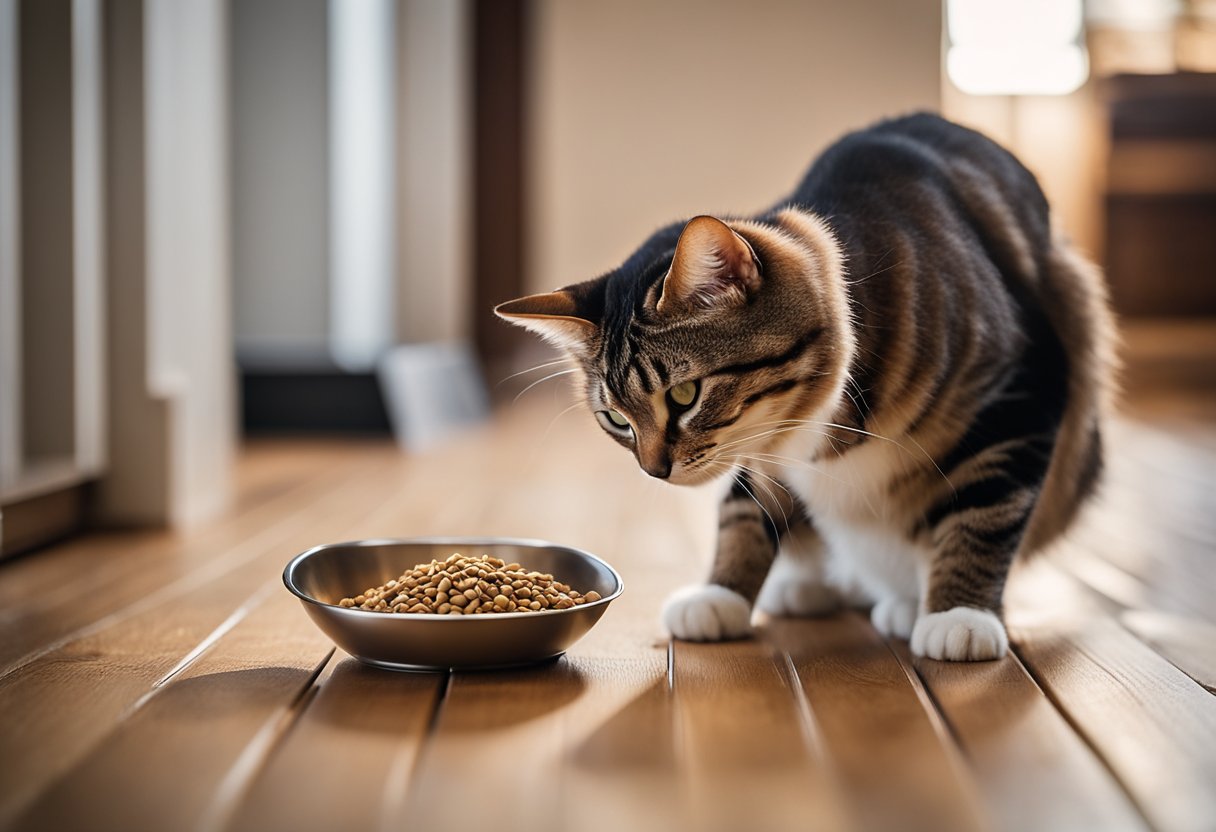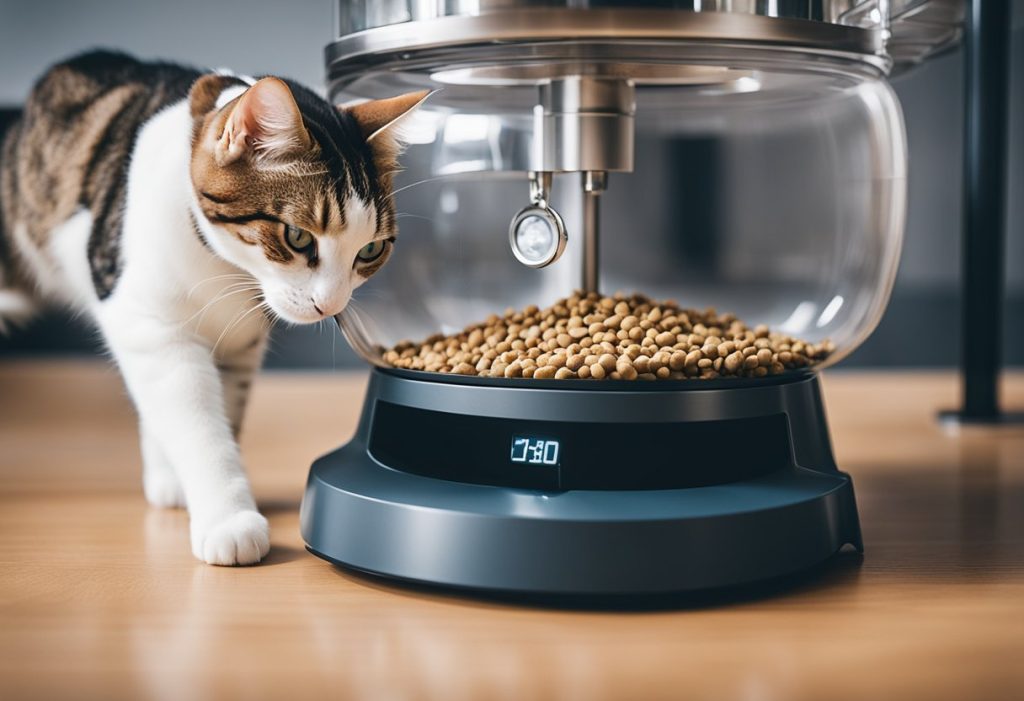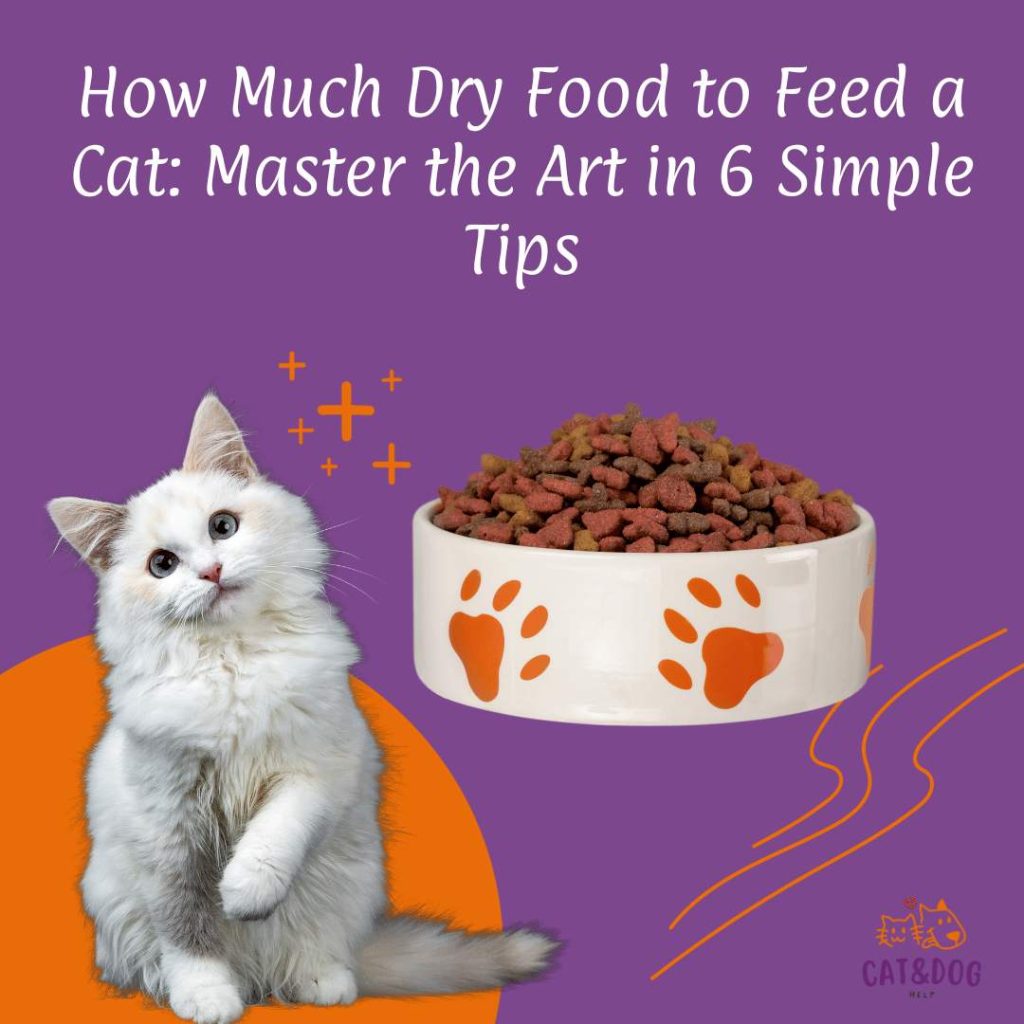Figuring out how much dry food to feed your cat can seem like a daunting task.
With so many factors to consider such as age, size, and activity levels, it’s essential to strike the right balance in meeting your feline companion’s nutritional needs.
Knowing the appropriate amounts can not only keep your cat healthy but also prevent overeating and weight gain.
In navigating these complexities, it can be helpful to understand some general guidelines and strategies when determining the right portion size for your cat.
This can vary depending on whether you’re feeding your cat exclusively dry food, or if a mix of wet and dry food is a part of their diet.
Paying close attention to the specific needs and habits of your cat can ensure a well-balanced and nutritious meal plan.
Key Takeaways
- Consider your cat’s unique factors such as age, size, and activity levels when determining dry food portions.
- Utilize charts and guidelines to tailor feeding strategies for your cat’s specific needs.
- Monitor your cat’s response to portion sizes and adjust accordingly for optimal health.
Factors That Affect How Much to Feed Your Cat

So, you’re wondering how much dry food to feed your furry feline friend?
The answer varies depending on several factors. Let’s explore them to help you make the right decision for your cat’s nutritional needs.
Growing kittens
First, you’ll have to consider your cat’s age. Kittens are still growing and require more food per pound of body weight to support their development.
Senior cats
On the other hand, senior cats may have a slower metabolism and fewer activity levels, meaning they’ll require fewer calories. Pay attention to the specific nutritional requirements listed on your cat food labels for different life stages.
Cat size
Your cat’s size and body condition are essential too. A smaller cat will require less food than a larger one, and an overweight cat might require a diet with fewer calories.
If you’re unsure about your cat’s ideal weight, consult with your veterinarian to determine any necessary adjustments.
Indoor or outdoor cat
Indoor cats tend to be less active and may require fewer calories than their outdoor counterparts, who roam and exercise more.
Active vs sedentary cat
Also, consider how active your furry friend is in general – an active cat will burn more calories than a less active one due to a higher metabolic rate.
Neutered or spayed cats
Neutered or spayed cats usually experience a decrease in their metabolism, making them prone to weight gain.
If your cat has been spayed or neutered, keep an eye on their weight and adjust their food intake accordingly.
In terms of nutrients, cats are obligate carnivores, meaning they require high levels of protein and a balanced blend of vitamins and minerals.
Make sure you choose a high-quality cat food that offers the necessary nutrients for your cat’s optimal health.
To summarize, numerous factors, including age, size, body condition, lifestyle, and metabolic rate, play a role in determining how much dry food to feed your cat. Don’t forget to monitor your cat’s weight, adjust their intake accordingly, and provide them with a balanced diet to ensure proper nutrition.
How Much to Feed a Cat Chart
So, you want to know how much dry food to feed your cat?
Maintaining a healthy weight for your feline friend is essential to prevent obesity and other health issues tied to overfeeding or underfeeding. Let’s dive into the world of portion control for your kitty!
First, determine your cat’s resting energy requirement (RER). This is the number of calories they need per day to maintain a healthy weight.
You can calculate your cat’s RER by using the following formula:
RER = 70 x (body weight in kg)^0.75. Don’t worry; it’s not as complicated as it sounds! (1)
Now that you’ve got your cat’s RER, it’s time to work on a feeding schedule. Feeding your cat small meals throughout the day is a great way to help them maintain their ideal body weight.
Here’s a simple cat feeding guide to help you portion out your cat’s food:
- Underweight cats: RER + 20% (For weight gain)
- Healthy weight cats: RER (For maintenance)
- Overweight cats: RER – 20% (For weight loss)
Another way to determine your cat’s daily calorie needs based on its specific weight and health status, use the calculator provided. check here.
In the illustration given, for a 10-lb neutered male cat, the daily intake would range about around 260 kcals. This varies with their age, activity level, and other considerations mentioned below, such as medical conditions.

Keep in mind that these are general guidelines, and individual needs may vary. It’s essential to monitor your cat’s weight and adjust their portions accordingly.
Aside from portion control, it’s crucial to choose the proper adult cat food for your feline friend. Look for nutritionally balanced formulas containing all the necessary nutrients to keep your cat happy and healthy.
Remember, maintaining your cat’s weight is a balancing act. Keep a watchful eye on their food intake and make adjustments as needed. In no time, you’ll master the art of feeding your cat the perfect amount of food to keep them in tip-top shape. Happy feeding!
How to Convert Calories into Portion Sizes
So, you want to make sure your cat is getting the right amount of food, right?
It’s essential to maintain a balance between underfeeding and overfeeding to keep their weight in check. Let’s dive into how to convert calories into portion sizes for your feline friend.
Firstly, you need to determine the calorie requirements for your cat. This typically depends on factors like their weight, activity level, and age. Knowing your cat’s ideal resting energy requirement (RER), calculated by weight (kg) 0.75 x 70, helps you to determine how many kcal/kg they need daily.
Keep in mind that lifestyle factors such as activity levels (inactive, average, or highly active) will impact this calculation.
Once you’ve got the calorie requirements sorted, it’s time to apply some portion control.
Take a look at the cat food packaging and find the kcal/kg information, which tells you the number of calories in each kilogram of food.
To find out how much dry food you should feed your cat, simply divide their daily calorie needs by the kcal/kg of the food.
For instance, if your cat requires 250 kcal per day and the dry food has a value of 4000 kcal/kg:
Portion size (in grams) = 250 kcal / 4000 kcal/kg = 0.0625 kg
Then, convert it to grams:
0.0625 kg * 1000 = 62.5 grams
So, in this case, you should be feeding your cat about 62.5 grams of dry food per day.
Remember, these are just guidelines, and it’s essential to keep an eye on your cat’s weight gain or loss to adjust the portions accordingly.
If they’re losing too much weight, consider increasing the food quantity, and if they’re gaining too much, try decreasing it. Cats, just like people, come in all shapes and sizes, so what works for one might not work for another.
In summary, converting calories into portion sizes helps maintain a healthy balance for your cat. By paying attention to their requirements, keeping track of their weight, and adjusting their portions accordingly, you’ll be well on your way to ensuring your feline companion stays happy, healthy, and at an ideal weight!
Feeding Wet Cat Food vs. Dry Cat Food
So, you’re wondering whether to feed your cat wet food or dry cat food?
It’s a common question, and you’re not alone! Let’s break down the differences between the two and how each type might impact your furry friend’s nutrition and health.
First off, wet cat food typically has a higher moisture content, usually around 78%, while dry cat food contains about 6-10% moisture.
This means that feeding wet food can help keep your cat hydrated, which is especially important for cats with urinary tract issues or those who don’t drink enough water on their own.
As for calories, dry cat food is often more energy-dense, allowing your cat to consume calories more quickly.
Additionally, dry food is more convenient as it doesn’t require refrigeration and has a longer shelf life compared to wet food. But don’t worry, wet cat food can also provide your cat with essential nutrients, like vitamins, minerals and taurine.
If you’re considering mixing the two, you’re in luck!
Many pet parents prefer a combination of both wet and dry cat food to give their cats the best of both worlds.
This way, your cat enjoys the benefits of hydration and additional nutrients from wet food while still getting the convenience and energy density of dry food.
When it comes to determining how much food to feed your cat, it’s essential to consider their weight. For instance, a cat weighing between 5-9 lbs may require about 1/3 to 2/3 cup of dry food per day, while a 10-14 lbs cat might need between 3/4 to 1 cup.
Using an Automated Cat Feeder

Automatic cat feeders can be a lifesaver, especially for busy cat parents. They help ensure that your feline friend gets the right amount of food at the right time, even when you can’t be there.
Using an automatic feeder is pretty straightforward. First, choose a feeder that suits your cat’s needs.
Some feeders are designed for both dry and wet foods, while others only work with dry food.
Opt for a feeder that holds at least a few days’ worth of food, in case you need to unexpectedly spend time away from home.
Once you’ve picked the perfect feeder, it’s time to determine how much food your cat requires.
This will depend on several factors, including age, weight, activity level, and any specific dietary requirements.
A general guideline for an adult cat is to feed them about 20-30 grams of dry food per kilogram of body weight per day.
However, it’s always best to consult your vet for personalized advice on the correct amount for your cat.
Now that you have the right feeder and know how much food your cat needs, it’s time to set the feeding schedule. Generally, cats should be fed two to three small meals per day.
You can program your automatic feeder to dispense these meals at regular intervals throughout the day. This way, your cat gets used to the routine and stays satiated.
As you start using the automatic feeder, it’s important to monitor your cat’s weight and overall health. Adjust the portion sizes if necessary, and consult your vet if you have any concerns.
Remember, consistency is key, so try to keep your cat’s feeding schedule as regular as possible.
That’s it! With these simple steps, you’ll be well on your way to successfully using an automated cat feeder. Embrace this modern pet care solution and enjoy peace of mind knowing your cat is well-fed and happy even when you can’t be there in person.
How Often To Feed a Cat
So you’re wondering how much and how often to feed your furry friend? Don’t worry, we’ve got you covered with this helpful cat feeding guide. Feeding cats properly is essential to ensure they stay healthy and happy.
The frequency of feeding your cat depends on their age and personal needs.
Generally, adult cats should eat one or two meals per day, while senior cats (age seven and above) can maintain the same feeding regimen. (2)
To avoid any stomach issues, it’s crucial not to let more than 12 hours pass between meals. (3)
If you have a growing kitten, their energy requirements are higher. They need about 300 to 500 calories per day and should gain approximately 1 pound per month. (4)
To meet these nutritional needs, you can consider feeding them small meals throughout the day.
Meal Planning
When it comes to meal planning, it’s essential to adapt to your family schedule. At a minimum, cats should eat two meals each day, approximately 12 hours apart. (5)
However, if possible, you can provide them with a breakfast, lunch, afternoon, dinner, and bedtime snack routine.
Remember that the information given here is a general guide. Every cat is unique, so it’s essential that you closely monitor your cat’s individual needs and adjust their feeding schedule accordingly.
Frequently Asked Questions
How much dry food should an adult cat eat daily?
The amount of dry food an adult cat should eat daily will depend on factors like their weight, age, and activity level. Generally, you can use the resting energy requirement (RER) formula to help determine the right amount of food for your cat’s needs. Remember to always consult with your veterinarian for specific recommendations.
What is the appropriate dry food portion for a kitten?
Kittens have different dietary needs from adult cats and require a high-quality protein-based diet. When they’re between 5 and 8 weeks old, you can offer them an unlimited amount of wet kitten food to support their rapid growth.
During this phase, gradually introduce dry food to their diet and keep track of their weight to adjust portions accordingly.
How often should I be feeding my cat dry food?
Cats generally prefer to eat small meals throughout the day, so it might be a good idea to provide them with a consistent supply of dry food.
However, you should monitor their total food intake, as overfeeding can lead to obesity and health issues. It’s best to consult your veterinarian for personalized advice on feeding frequency.
What are the differences in feeding dry and wet food to a cat?
Both dry and wet cat food can provide the necessary nutrients for your pet, but they have some differences. Dry food has a longer shelf life and can be more convenient for busy pet owners.
On the other hand, wet food has a higher water content, helping to keep your cat hydrated. Many cat owners choose to feed a combination of both dry and wet food to ensure their pets get a balanced diet.
How does a cat’s age affect the amount of dry food they need?
As cats age, their nutritional needs may change. Older cats might have a slower metabolism, requiring fewer calories than younger, more active cats. It’s essential to monitor your cat’s weight and adjust their portion sizes accordingly. If you notice any significant changes in their eating habits or weight, consult your veterinarian for guidance.
Is there a feeding chart to estimate the proper amount of dry food?
Yes, there are feeding charts available to help you estimate the proper amount of dry food for your cat based on factors like their weight, age, and activity level. One such chart can be found on this cat food calculator. Keep in mind that these charts are general guidelines and that it’s essential to consult your veterinarian for personalized recommendations.
- онлайн казино 7К - July 12, 2025
- сайт интернет казино 7К - July 12, 2025
- казино 7К в России - July 11, 2025


